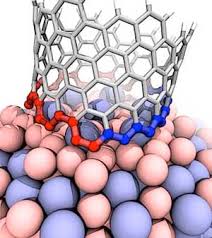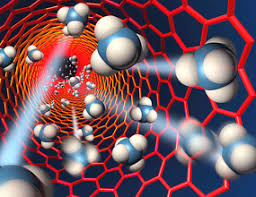Distribution of nanotubes by NIR-vis-UV absorption spectroscopy based on nano-microelectronics Ph.D.
Researcher and author: PhD student Afshin Rashid
Note: Distribution of nanotubes by absorption spectroscopy of two adjacent nanotubes by interaction of carbon with van der Waals bond energy can form batches or parallel strands . Creating clusters in the electronic structure of the tubes causes perturbations and redshifts of their absorption peaks, causing the peaks to overlap and fade, eventually confusing the spectrum structure.
In addition, the presence of layers prevents the selective reaction of internal nanotubes, which confuses the purification of nanotubes by their size or type or their use as macromolecular species . Therefore NIR-Vis-UV absorption spectroscopy can be used to examine sample population or sample size. If the distribution of the nanotubes by NIR-vis-UV absorption spectroscopy is desired, the sample must be dispersed or in a thin layer . Optical absorption measurements provide useful information on the electronic properties of SWCNTs and can be used to study covalent and non-covalent interactions between molecules and nanotubes.
When the functional groups are covalently bound to the nanotube, the absorption peaks are either markedly weakened or even disappear because the structure of the nanotube in some hexagonal SP2 changes to the structure of parts of the structure of SP3. NIR-VIS-UV absorption spectroscopy has two important uses: covalent reaction rates and selectivity for different nanotubes . Non-covalent doping or molecular absorption results in the production of valence-like electrons (dopingP ) or doping-n saturation . These non-covalent interactions can affect the intensity of the absorption peaks . When doping, electrons such as (Cs, K) or acceptors They produce very similar changes in the spectrum (-Br2 ) such as NIR-vis-UV and both weaken the electron transfer. Absorption spectroscopy is used to estimate the abundance of metallic and semiconductor species by comparing the intensities of the corresponding peaks because the position of these resonant peaks depends on chirality and diameter. For qualitative analysis , absorption spectroscopy is excellent because it shows the general character of the sample composition, but quantitative evaluation depends on (m, n) for several possible reasons . It is reported that the extinction coefficient ratio for metal-to-semiconductor SWCNTs is + 0.352, which should be independent of the - 0/009 separation or starting materials method. But the values The reported extinction coefficients of SWCNTs are not consistent with the scientific literature, and better quantification methods are still needed to determine the extinction coefficient of different nanotubes (m, n). Second, strong absorption in the short wavelength region makes the resonant transitions not distinct.
Conclusion :
Some samples have high impurities, such as graphitic polyhedral particles, amorphous carbon, and catalyst particles. The optical absorption of these impurities is related to the spectrum and is necessary for quantitative evaluation of the field removal of the field absorption, which would not be possible in this case and the quantitative analysis would be error-free . The third problem is due to the presence of dispersant, which is dispersed when the nanotube is dispersed , leading to misleading quantitative detection of SWCNT in the state.
In addition, the complexity of overlapping peaks is problematic. As a result, the existence of a large number of SWCNTs with different (m, n) of unknown abundance along with various errors associated with information analysis makes it difficult to quantify the specific species concentration (m, n) in the sample and only estimate data . it will be obtained.





